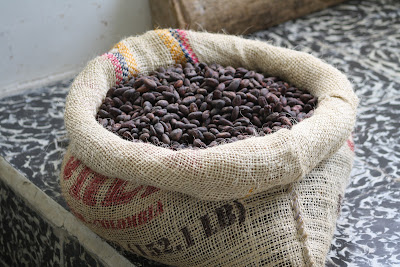Just received a fresh cacaopod, form Colombia, how nice is this!!
Shall open this one very soon...



Last year in July, Suzie Hoban came to Kortrijk for a visit at my place, see her writing on her blog:
http://www.cupcakeq.com/blog/2011/7/9/chocolate-vercruysse.html
Later she started her own business in Colombia, where she is now a chocolatier in Bogot:Guau!
The City Paper "business" asked her to do some preview of the future of the Colombian chocolate. Read her story:

Consider yourself a chocolatelover? Well, you are amongfriends, many friends in fact,that are growing in number every day.Fuelled by the developing economiesof Brazil, Russia, India, and China, theworldwide demand for chocolate is increasingat 2.5% a year. This may seemlike a small number, but it presents adire problem for chocolate manufacturersas they struggle to source sufficient
quantities of chocolates raw material:cacao.
The Theobroma Cacao tree whichproduces cacao beans, will only growwithin 20 degrees of the equator. Over70% of the worlds beans are grown inAfrica whilst the remaining 30% are
cultivated in Asia and Latin America.If chocolate consumption continuesto grow at this rate, by 2020 we willneed another million tonnes of cacaobeans, equivalent to the current outputof the worlds largest producer, theIvory Coast.
This problem for chocolate manufacturersis a great opportunity for cacaoproducing countries, including Colombia.To capitalise on the worlds growingdesire for chocolate, the Colombian Government has released an ambitiousten year plan to transform Colombiafrom its current status as cacao importer,to major cacao exporter. Accordingto the Plan Decenal, Colombia will increase production of cacao from the42,000 tonnes produced in 2010, to79,000 tonnes in 2014, and to 246,000tonnes by2021.
Fedecacao, the national associationof cacao growers, will be instrumental inachieving this plan. By providing technicalassistance to farmers, they aim totriple the current yield on existing plantations,and will expand cacao productioninto new regions, including manyareas formerly used for coca production.Edgar Aldana Rosillo of Fedecacaosays the Plan Decenal will not only helpfarmers, but entire rural communitiesby providing permanent jobs and liveable incomes for families, thus reducingthe displacement of rural populations.
Fedecacao estimates that the PlanDecenal will create 76,500 jobs directlyinvolved in cacao cultivation and38,250 additional jobs in the broaderindustry.



The success of Plan Decenal relieson consistently high prices for cacao andthis is not something that can be guaranteed,especially not for a crop that theUnited Nations Conference on Tradeand Development described as one ofthe most volatile commodities in theworld. Whilst global demand for cacaois currently pushing prices up, many factorscan bring them back down, suchas the introduction of substitute productsfrom other countries. Malaysia recentlybegan exporting huge quantitiesof cocoa powder, a product that can beused in many chocolate flavoured foodsin place of cacao, for approximately onesixth of the price. Fedecacao reportedin March that a sudden influx of cocoapowder in Colombia caused the priceof cacao to drop nearly 50% in just sixmonths.
Producers of bulk or low-qualitycacao have no choice but to sell on thecommodities market, however producersof high-quality beans can sell themdirectly to quality chocolate manufacturers,
who pay a premium up to threetimes the market price. Amounting toless than 10% of global cacao producion,these Fine Aroma beans arehighly sought after by the growing numberof artisanal bean-to-bar chocolateproducers.
According to international chocolate consultant Chloe Doutre-Roussel,these artisanal producers prize beansfrom Venezuela, Madagascar, Peru, andMexico, however they know little aboutthe quality of Colombian cacao. Totackle this problem, Fedecacao is busypromoting quality Colombian beans
to international buyers. In October2011, through the support of this entity,farmer Sal Tirado Fuentes won aCocoa of Excellence award at the Salondu Chocolat in Paris, for cacao grownon his Valparaiso plantation in Arauquita,Arauca.

The judges noted thatthe beans, from a tree developed by theresearch department of Fedecacao, exhibiteddistinct sweet caramel aromas.Awards such as these are crucial in establishingboth the high quality, andthe unique regional characteristics ofColombian cacao.
At the farm level, Fedecacao agronomistsare advising farmers on cultivation,fermentation and drying techniques tomaximise the unique characteristics oftheir land and their trees.Colombian chocolate companyCasa Luker is also working hard to improvethe quality of Colombian beans.Traditionally a manufacturer of drinkingchocolate, in 2009 the companybegan selling couverture, the chocolate
used by chocolatiers. To meet the highstandards demanded by their internationalclients, Luker conducts researchon their own cacao plantation, GranjaLuker. By working with 35 growingco-operatives in Colombia, Luker canshare its research findings with over5,000 cacao growing families, ensuringa steady supply of quality beans, nowand in the future.
With this assistance at the plantationlevel, and the right exposure internationally,Colombian farmers mayjoin their neighbours as some of thebest paid-cacao growers globally, whilstensuring the worlds chocolate lovers afuture for their favourite treat.
A visit from the International Business Director, Francisco Javier Gomez B. of Casa Luker at my place to see how I create chocolates with the Casa Luker Colombian FINO DE AROMA couverture.
http://www.lukercacao.com/












